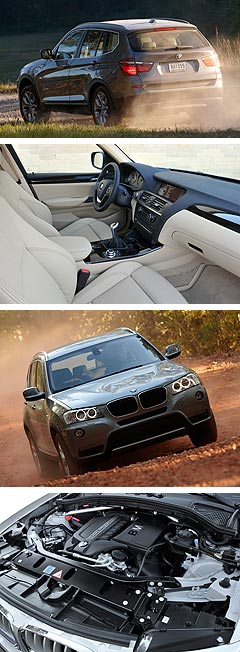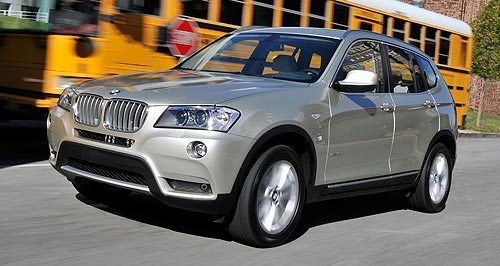Make / Model Search
Future models - BMW - X3First drive: BMW’s new X3 impressesFighting torque: The new X3 will have more competitors to face than when the original model was launched back in 2004. BMW addresses criticisms of its popular mid-size X3 SUV with second generation8 Nov 2010 By JAMES STANFORD in ATLANTA BMW has significantly reworked its X3 SUV in the face of more opposition than when the mini-version of the X5 first appeared in 2004. The Bavarian car-maker has addressed criticism for the X3’s relatively ordinary handling and cheap-looking exterior while making the X3 larger (with considerably more interior space), more comfortable and making it available with a raft of cutting-edge technology such as heads-up information display, active cruise control and birds-eye parking view as well as fresh powertrains. It will come to Australia around March 2011. The much-improved X3 will help it fight off the Audi Q5 and Volvo XC60 (as well as the Mercedes-Benz GLK in left-hand drive markets), vehicles that did not exist when the original X3 was introduced.  The X3 now has a wheelbase of 2810mm, only 15mm longer than before, but is very nearly as big as the first-generation X5. It is built on a stretched version of the existing platform, which is based on the 3 Series base rather than the next generation 3 Series platform. The X3 now has a wheelbase of 2810mm, only 15mm longer than before, but is very nearly as big as the first-generation X5. It is built on a stretched version of the existing platform, which is based on the 3 Series base rather than the next generation 3 Series platform.The weight range kicks off at 1715kg, within a few kg of the existing model. BMW says the useable interior space has been increased with more leg and elbow room. The rear seats are designed in a 40:20:40 layout for maximum practicality and with all seats down the cargo room expands from 500 litres to 1600 litres. Underneath, BMW has changed the multi-link suspension system, opting for a front set-up that uses double-joint spring struts, and has added Dynamic Damper Control for the first time on an X model. This system uses electronically controlled dampers that react to the road conditions as well as driving style and is controlled via centre console buttons for Normal, Sport and Sport + modes that also alter throttle actuation, power steering assistance and transmission shift points. BMW has introduced new electric-assisted power steering and the handling has been improved by widening the track 92mm. The 20d diesel model sits on 17-inch alloys, while 18s and 19s are also available. The new X3 has constant all-wheel drive with a default setting that sends 40 per cent of torque to the front and 60 per cent to the rear. This system works with the electronic stability control to brake an inside rear wheel and send more power to the other rear wheel in order to improve cornering. Two engines will be available at launch, including a turbo-diesel four-cylinder and a yet-to-be-announced naturally aspirated six-cylinder petrol. A more potent six-cylinder diesel is expected to join the line-up at a later date. In many overseas markets, BMW is also offering a 35is 3.0-litre turbo petrol six-cylinder with a salivating 225kW and 400Nm, which is enough to sling the X3 from 0-100km/h in just 5.7 seconds, but this engine will not make it to Australia. The entry-level diesel that will be available from launch is a revised version of the existing 2.0-litre four-cylinder common-rail turbo, which generates 135kW at 4000rpm and 380Nm between 1750rpm and 2750rpm (up four per cent and nine per cent respectively). Fuel consumption is an impressive 5.6 litres per 100km, which is a dramatic 14 per cent improvement. This engine is teamed with a ZF automatic transmission that has no less than eight gears and is already available in the 5 Series as well as high-end Audi models including the A8. It is a traditional-type torque-convertor auto, not a dual-clutch system and will be standard on the Australian models as we will not be taking the six-speed manual. The auto is available with an idle-stop feature that kills the engine at idle and fires it up again when you are ready to go. Although it comes with hill descent control to aid steep downhill journeys, the X3 is still a city slicker with ground clearance of 212mm (up from 201mm) and an unchanged 500mm wading depth. The X3 looks similar to the existing model from some perspectives, especially at the front, but is actually considerably different. It has some dramatic design elements such as the crease running up the sides, and many of the straighter lines and edges have been replaced by more flowing elements. The increased length and width have allowed the designers to give it a more planted look. There is an asymmetric dashboard design with the centre console angled towards the driver. A colour centre screen is up to 8.8 inches in size in the higher grade models and there is, of course, an iDrive controller in the centre console. BMW is yet to lock in pricing, but expect the new X3 to remain at or around the current level, which is $62,200 for the diesel and $69,500 for the petrol. Drive impressions: THE BMW X3 has always been the model you buy when you can’t afford an X5. In fact, the brilliant driving characteristics, comfort, design and layout of the X5 have made life tough for the X3. The X5 is so good and the X3 was so, well, ordinary. Launched in 2004, the first-generation didn’t handle very well, it felt underdone inside, it looked cheap thanks largely to the overuse of black plastic and it seemed with an all-too-narrow stance. Facelifts helped, but there was only so much that could be done to that model. The new X3 is significantly better in many ways and it is now like a more compact and more affordable version of an X5 that you’d be happy to be seen driving. Some people might now choose it over the larger X5 if the larger car’s size is an issue. We tested the X3 at its international launch near Atlanta, Georgia, which is just up the road from where it is made in South Carolina. Unfortunately, we weren’t able to drive the exact models that will come to Australia. We drove the Oz-bound diesel, but with a manual transmission instead of the automatic transmission we will get. We did test the auto, but in the 35is model with the slingshot turbo-six that won’t be coming Down Under. Even so, the drive illustrated the vehicle’s strengths and showed how far it has come. The first thing you notice is the vastly improved styling. It doesn’t look all that different from the last one in some photos, but the change is dramatic in the metal. The front end is a little cleaner, but it is the fresh and muscular lines of the sides and back that give it a more planted look. The designers have taken advantage of the wider body to give it a tougher stance. Some colours show the lines better, but it is a good-looking car in any colour. The interior now looks more up-market. The dashboard and centre console is your standard BMW set-up with a crisp display, and graphic display beneath the speedo and tacho that gives it a modern appearance. There is more space inside and rear passengers have more than adequate legroom and headroom. The ability to fold the rear seats down in 40/20/40 format makes it more practical and the boot is also quite reasonably sized. BMW appears to have improved the refinement significantly. We will need to test it on our coarse-chip roads for a true indication, but on US bitumen the X3 sounded very quiet. The ride also seemed to be comfortable enough and the increased track and re-worked suspension seem to have improved the handling. Our test route didn’t cover the kind of windy roads to explore the cornering capabilities, but the X3 certainly felt agile when it did get a crack at a corner. It appeared to be much better tied down with less body roll, while the steering was accurate. The diesel engine has a good supply of torque, but you can get caught out if you pick a gear that is too high and drop off the boost, and it’s not the quietest diesel we’ve driven. Fuel consumption came in at around 7.0L/100km, which is higher than the claimed average, but still very good for a vehicle of this size, especially as we were giving it a hard time. ZF has done a great job with the eight-speed auto, which is well-calibrated and a huge improvement over the original X3 diesel auto. You would be right to worry that an eight-speed auto would constantly change gears, but that isn’t the case. It can quickly jump two or more gears at a time and, in standard mode, works away quietly and efficiently. You just don’t notice it. The optional Sport function allows for super-fast changes when you are feeling sporty. They certainly are hard and fast. The regular BMW transmission shifter is tricky to use unless you drive it regularly because it is very hard to tell whether you are in park, drive or reverse when you are in a hurry. It’s a pity we won’t be getting the 35is turbo six because it really goes hard. I’ve never thought of the X3 as a sporty car, but this engine challenges that idea. There is a power burst from about 1500rpm all the way through to 7000rpm and it certainly sounds good at that point. BMW doesn’t want to bring this engine to Australia because it is getting a bit close to the entry levels of the X5 range. That’s a shame. The rest of the X3 package is impressive and represents a vast improvement over the current model.  Read more15th of July 2010  First look: BMW lets all-new X3 looseSecond-generation BMW X3 compact SUV emerges ahead of Paris motor showAll future models Alfa Romeo Alfa Romeo Abarth Abarth Alpine Alpine Alpina Alpina Audi Audi Aston Martin Aston Martin BMW BMW Bentley Bentley Chery Chery Brabham Brabham Chrysler Chrysler Chevrolet Chevrolet Cupra Cupra Citroen Citroen DS DS Dodge Dodge Fiat Fiat Ferrari Ferrari Foton Foton Ford Ford Great Wall Great Wall FPV FPV Haval Haval GWM GWM Honda Honda Holden Holden Hummer Hummer HSV HSV Infiniti Infiniti Hyundai Hyundai Jaguar Jaguar Isuzu Isuzu Kia Kia Jeep Jeep Land Rover Land Rover Lamborghini Lamborghini Lexus Lexus LDV LDV Mahindra Mahindra Lotus Lotus Mazda Mazda Maserati Maserati Mercedes-AMG Mercedes-AMG McLaren McLaren MG MG Mercedes-Benz Mercedes-Benz Mitsubishi Mitsubishi Mini Mini Opel Opel Nissan Nissan Peugeot Peugeot Pagani Pagani Proton Proton Porsche Porsche Renault Renault Ram Ram Rover Rover Rolls-Royce Rolls-Royce Skoda Skoda Saab Saab SsangYong SsangYong Smart Smart Suzuki Suzuki Subaru Subaru Toyota Toyota Tesla Tesla Volvo VolvoX3 pricing
Motor industry news |
Click to shareBMW modelsResearch BMW All future models Alfa Romeo Alfa Romeo Abarth Abarth Alpine Alpine Alpina Alpina Audi Audi Aston Martin Aston Martin BMW BMW Bentley Bentley Chery Chery Brabham Brabham Chrysler Chrysler Chevrolet Chevrolet Cupra Cupra Citroen Citroen DS DS Dodge Dodge Fiat Fiat Ferrari Ferrari Foton Foton Ford Ford Great Wall Great Wall FPV FPV Haval Haval GWM GWM Honda Honda Holden Holden Hummer Hummer HSV HSV Infiniti Infiniti Hyundai Hyundai Jaguar Jaguar Isuzu Isuzu Kia Kia Jeep Jeep Land Rover Land Rover Lamborghini Lamborghini Lexus Lexus LDV LDV Mahindra Mahindra Lotus Lotus Mazda Mazda Maserati Maserati Mercedes-AMG Mercedes-AMG McLaren McLaren MG MG Mercedes-Benz Mercedes-Benz Mitsubishi Mitsubishi Mini Mini Opel Opel Nissan Nissan Peugeot Peugeot Pagani Pagani Proton Proton Porsche Porsche Renault Renault Ram Ram Rover Rover Rolls-Royce Rolls-Royce Skoda Skoda Saab Saab SsangYong SsangYong Smart Smart Suzuki Suzuki Subaru Subaru Toyota Toyota Tesla Tesla Volvo VolvoX3 pricing
Motor industry news |











Facebook Twitter Instagram